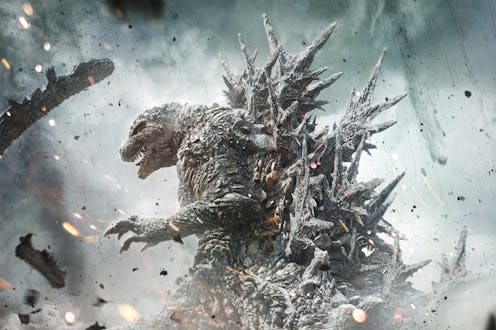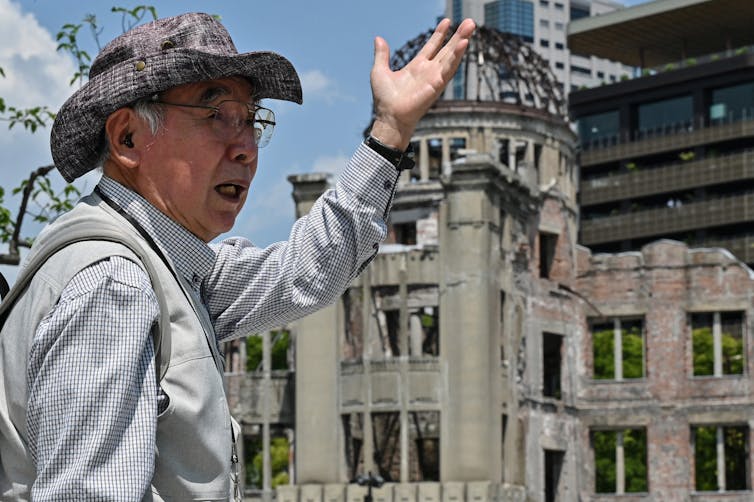Godzilla at 70: The monster’s warning to humanity is still urgent
Like the Japanese atomic survivors who were awarded the 2024 Nobel Peace Prize, Godzilla has a message to share.

The 2024 Nobel Peace Prize has been awarded to Nihon Hidankyo, the Japan Confederation of A- and H-bomb Sufferers Organizations. Many of these witnesses have spent their lives warning of the dangers of nuclear war – but initially, much of the world didn’t want to hear it.
“The fates of those who survived the infernos of Hiroshima and Nagasaki were long concealed and neglected,” the Nobel committee noted in its announcement. Local groups of nuclear survivors created Nihon Hidankyo in 1956 to fight back against this erasure.

Around the same time that Nihon Hidankyo was formed, Japan produced another warning: a towering monster who topples Tokyo with blasts of irradiated breath. The 1954 film “Godzilla” launched a franchise that has been warning viewers to take better care of the Earth for the past 70 years.
We study popular Japanese media and business ethics and sustainability, but we found a common interest in Godzilla after the 2011 earthquake, tsunami and meltdown at Japan’s Fukushima Daiichi nuclear plant. In our view, these films convey a vital message about Earth’s creeping environmental catastrophe. Few survivors are left to warn humanity about the effects of nuclear weapons, but Godzilla remains eternal.
Into the atomic age
By 1954, Japan had survived almost a decade of nuclear exposure. In addition to the bombings of Hiroshima and Nagasaki, the Japanese people were affected by a series of U.S. nuclear tests in the Bikini Atoll.
When the U.S. tested the world’s first hydrogen bomb in 1954, its devastation reached far outside the expected damage zone. Though it was far from the restricted zone, the Lucky Dragon No. 5 Japanese fishing boat and its crew were doused with irradiated ash. All fell ill, and one fisherman died within the year. Their tragedy was widely covered in the Japanese press as it unfolded.
This event is echoed in a scene at the beginning of “Godzilla” in which helpless Japanese boats are destroyed by an invisible force.
“Godzilla” is full of deep social debates, complex characters and cutting-edge special effects for its time. Much of the film involves characters discussing their responsibilities – to each other, to society and to the environment.
This seriousness, like the film itself, was practically buried outside of Japan by an alter ego, 1956’s “Godzilla, King of the Monsters!” American licensors cut the 1954 film apart, removed slow scenes, shot new footage featuring Canadian actor Raymond Burr, spliced it all together and dubbed their creation in English with an action-oriented script they wrote themselves.
This version was what people outside of Japan knew as “Godzilla” until the Japanese film was released internationally for its 50th anniversary in 2004.
From radiation to pollution
While “King of the Monsters!” traveled the world, “Godzilla” spawned dozens of Japanese sequels and spinoffs. Godzilla slowly morphed from a murderous monster into a monstrous defender of humanity in the Japanese films, a transition that was also reflected in the later U.S.-made films.
In 1971, a new, younger creative team tried to define Godzilla for a new era with “Godzilla vs. Hedorah.” Director Yoshimitsu Banno joined the movie’s crew while he was promoting a recently completed documentary about natural disasters. That experience inspired him to redirect Godzilla from nuclear issues to pollution.
World War II was fading from public memory. So were the massive Anpo protests of 1959 and 1960, which had mobilized up to one-third of the Japanese people to oppose renewal of the U.S.-Japan security treaty. Participants included housewives concerned by the news that fish caught by the Lucky Dragon No. 5 had been sold in Japanese grocery stores.
At the same time, pollution was soaring. In 1969, Michiko Ishimure published “Paradise in the Sea of Sorrow: Our Minamata Disease,” a book that’s often viewed as a Japanese counterpart to “Silent Spring,” Rachel Carson’s environmental classic. Ishimure’s poetic descriptions of lives ruined by the Chisso Corp.’s dumping of methyl mercury into the Shiranui Sea awoke many in Japan to their government’s numerous failures to protect the public from industrial pollution.
“Godzilla vs. Hedorah” is about Godzilla’s battles against Hedorah, a crash-landed alien that grows to monstrous size by feeding on toxic sludge and other forms of pollution. The film opens with a woman singing jazzily about environmental apocalypse as young people dance with abandon in an underground club.
This combination of hopelessness and hedonism continues in an uneven film that includes everything from an extended shot of an oil slick-covered kitten to an animated sequence to Godzilla awkwardly levitating itself with its irradiated breath.
After Godzilla defeats Hedorah at the end of the film, it pulls a handful of toxic sludge out of Hedorah’s torso, gazes at the sludge, then turns to stare at its human spectators – both those onscreen and the film’s audience. The message is clear: Don’t just lazily sing about imminent doom – shape up and do something.
“Godzilla vs. Hedorah” bombed at the box office but became a cult hit over time. Its positioning of Godzilla between Earth and those who would harm it resonates today in two separate Godzilla franchises.
One line of movies comes from the original Japanese studio that produced “Godzilla.” The other line is produced by U.S. licensors making eco-blockbusters that merge the environmentalism of “Godzilla” with the spectacle of “King of the Monsters.”
A meltdown of public trust
The 2011 Fukushima disaster has now become part of the Japanese people’s collective memory. Cleanup and decommissioning of the damaged nuclear plant continues, amid controversies around ongoing releases of radioactive water used to cool the plant. Some residents are allowed to visit their homes but can’t move back there while thousands of workers remove topsoil, branches and other materials to decontaminate these areas.
Before Fukushima, Japan derived one-third of its electricity from nuclear power. Public attitudes toward nuclear energy hardened after the disaster, especially as investigations showed that regulators had underestimated risks at the site. Although Japan needs to import about 90% of the energy it uses, today over 70% of the public opposes nuclear power.
The first Japanese “Godzilla” film released after the Fukushima disaster, “Shin Godzilla” (2016), reboots the franchise in a contemporary Japan with a new type of Godzilla, in an eerie echo of the damages of and governmental response to Fukushima’s triple disaster. When the Japanese government is left leaderless and in disarray following initial counterattacks on Godzilla, a Japanese government official teams up with an American special envoy to freeze the newly named Godzilla in its tracks, before a fearful world unleashes its nuclear weapons once again.
Their success suggests that while national governments have an important role to play in major disasters, successful recovery requires people who are empowered to act as individuals.
The authors do not work for, consult, own shares in or receive funding from any company or organization that would benefit from this article, and have disclosed no relevant affiliations beyond their academic appointment.
Read These Next
Can scientists detect life without knowing what it looks like? Research using machine learning offer
A new machine learning model explores the boundary between biological and nonbiological chemistry.
How a niche Catholic approach to infertility treatment became a new talking point for MAHA conservat
Mainstream medical organizations have criticized ‘restorative reproductive medicine,’ but some Catholics…
How I rehumanize the college classroom for the AI-augmented age
A writer instructor recognizes the role of AI on campus, while elevating social connection and humanity…






